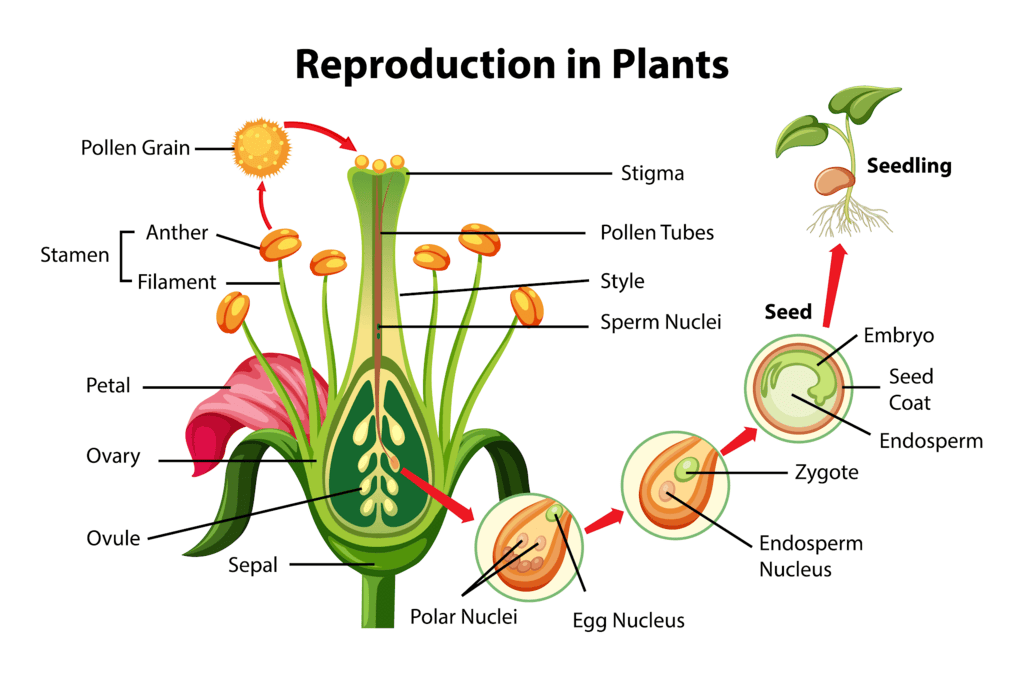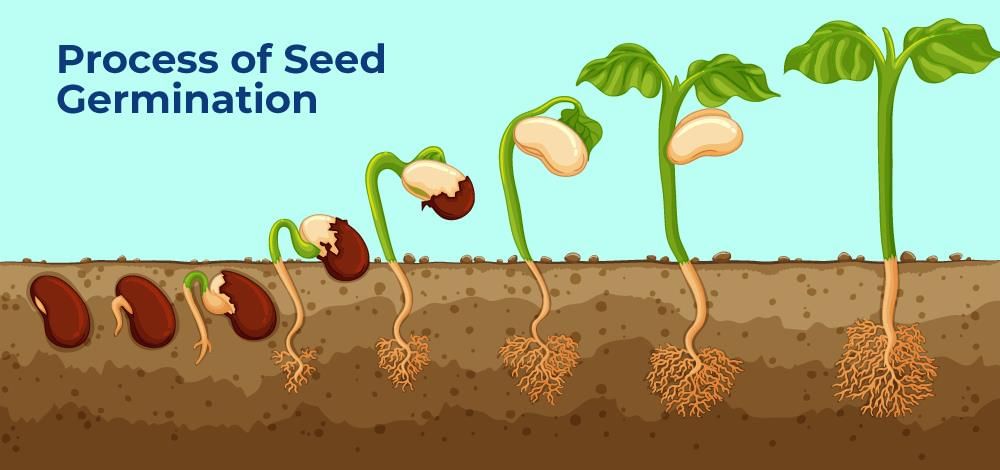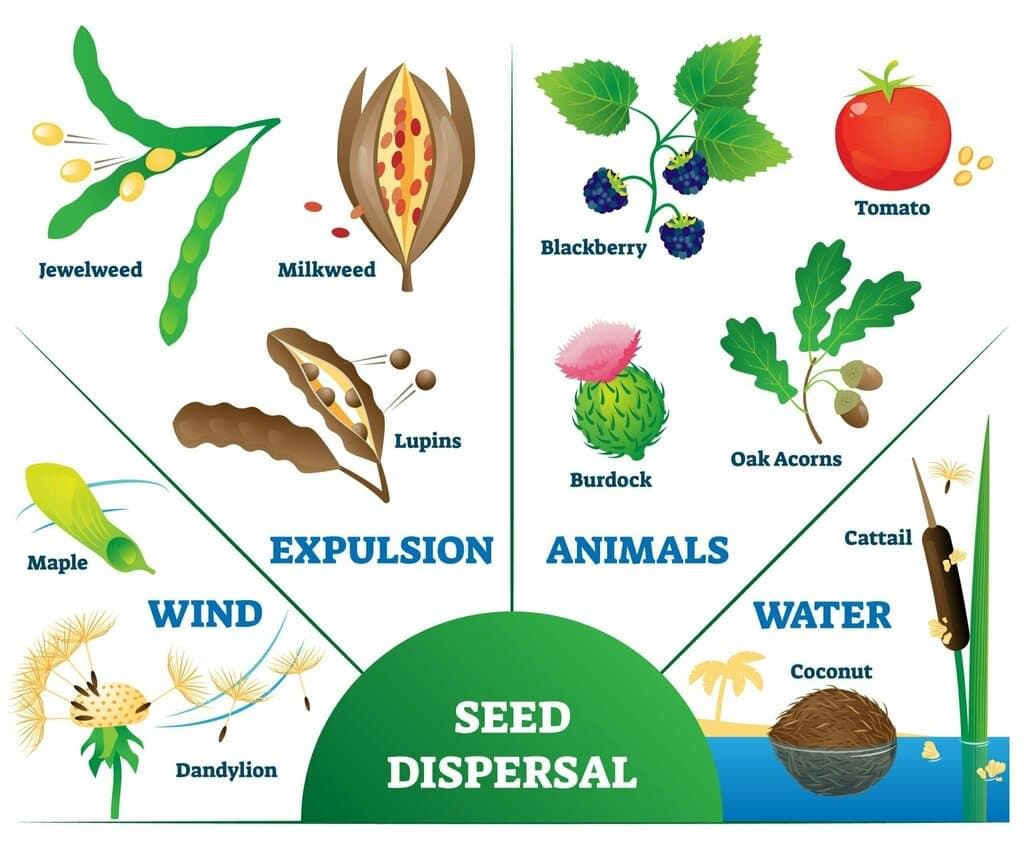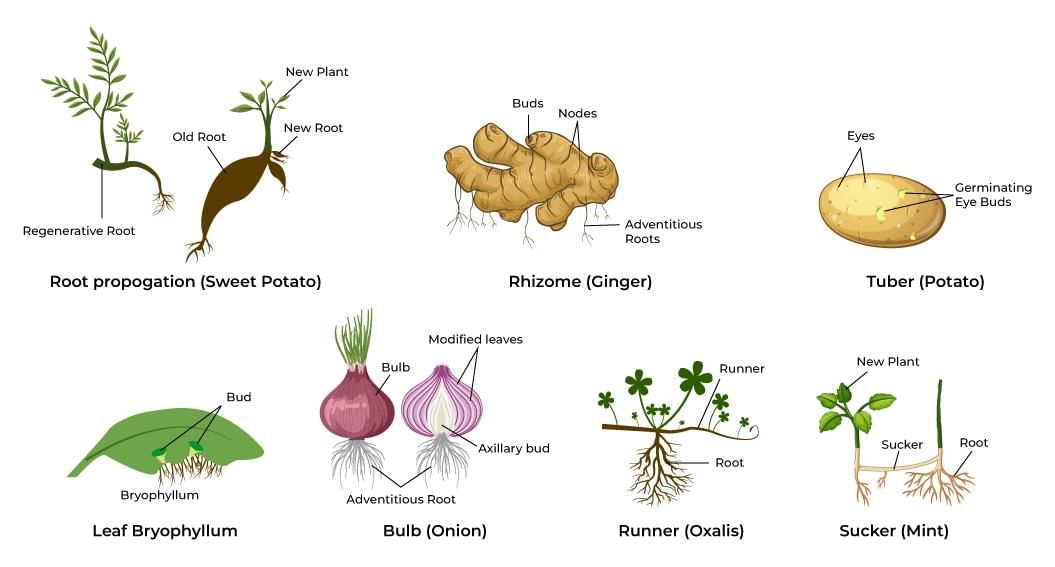Plant Reproduction Chapter Notes | Science Class 5 ICSE PDF Download
| Table of contents |

|
| Introduction |

|
| Sexual Reproduction in Plants |

|
| Germination |

|
| Need of Dispersal for Survival |

|
| Other Ways of Reproduction in Plants: Vegetative Reproduction |

|
| Points To Remember |

|
| Glossary |

|
Introduction
Plant reproduction is the way plants make new plants of their own kind. It is important for plants to reproduce so their species can continue to live on Earth. Plants can make new plants using seeds, roots, stems, or leaves. There are two main ways plants reproduce: sexual reproduction, which involves male and female parts, and vegetative reproduction, which uses other plant parts like stems or roots. This chapter explains how plants reproduce, how seeds grow, and how new plants are formed in different ways.
Sexual Reproduction in Plants

- In sexual reproduction, two parents, male and female, are needed to make a new plant.
- Male and female reproductive cells are called gametes.
- The male gamete and female gamete join to form a single cell called a zygote.
- The zygote divides many times to become a multicellular structure called an embryo.
- In plants, the embryo formed after sexual reproduction is inside the seed.
- The stamen is the male part of a flower, and it has an anther and filament.
- The anther in the stamen makes pollen grains, which contain the male gametes.
- The pistil is the female part of a flower, and it has a stigma, style, and ovary.
- The stigma is at the top of the pistil, and it is sticky to catch pollen grains during pollination.
- The ovary in the pistil contains the ovule, which has the female gamete.
Fertilisation
- Pollen grains land on the stigma of the pistil and form a tube called a pollen tube.
- The pollen tube carries the male gamete through the style to reach the ovule in the ovary.
- The ovule contains the female gamete.
- The male gamete joins with the female gamete to form a new cell called a zygote.
- The process of the male and female gametes joining together is called fertilisation.
Formation of Fruit and Seeds
- After fertilisation, the sepals, petals, and other parts of the flower, except the ovary, dry up and fall off.
- Once the zygote is formed, it divides many times to form an embryo.
- While the zygote divides and grows, the ovary starts to develop into a fruit.
- The ovules inside the ovary start developing into seeds.
- The embryo formed after fertilisation has two leaf-like parts called cotyledons and is surrounded by a protective covering called the seed coat, which develops from the ovule wall.
- The embryo has cells that later grow into a new plant.
Germination
- The process in which a seed develops into a seedling or a young plant is called germination.
- The seed needs the right conditions like proper soil, water, sunlight, and air to grow into a plant.
- In the right conditions, the seed coat becomes soft and spongy.
- At this stage, the seedling breaks the seed coat and comes out of the seed.
- The seedling first gets its food from the cotyledons and then from the soil.
- The seedling develops roots and a shoot; the roots grow underground and absorb water and nutrients from the soil.
- The shoot grows above the ground, develops leaves and branches, and finally becomes a plant.

Stages of Germination in a Seed
- Stage 1: The seed absorbs water, and the seed coat softens.
- Stage 2: The seedling breaks the seed coat and starts to grow using food from the cotyledons.
- Stage 3: Roots grow downward, and a shoot grows upward.
- Stage 4: The shoot develops leaves and branches, becoming a young plant.
Need of Dispersal for Survival
- Not all seeds grow into plants because some get damaged by animals, insects, wind, or water.
- Some seeds may not get the right conditions for growth, like soil, air, water, or warmth.
- When too many seeds fall near the parent plant, they compete for space, water, and sunlight, so only a few survive while others die.
- To avoid growing too close to each other, seeds need to be dispersed or spread away from the parent plant.
- Agents like wind, water, and animals help scatter the seeds; this process of scattering seeds away from the parent plant is called dispersal.

Agents of Dispersal
- Dispersal is done by agents like wind, water, animals, and explosion, which help scatter seeds away from the parent plant.
- Plants have special features that help in dispersal depending on the agent involved.
Wind
- Seeds of plants like cotton, sycamore, and dandelion are very light and have wing-like structures or hair on them.
- These features allow the seeds to be easily carried away by the wind.
- For example, dandelion seeds are light and have hair, which helps them float in the air and travel far.
Water
- Seeds or fruits of plants growing near or in water are spongy or fibrous, which helps them float on water.
- Water carries these seeds or fruits to different places.
- For example, coconut, lotus fruit, and seeds of mangrove plants are carried away by water.
Animals
- Humans and animals eat fleshy fruits like apples, mangoes, etc., and throw away their seeds in different places.
- These seeds can germinate into new plants if they get the right conditions for growth.
- Some birds and animals eat fruits and swallow the seeds, and the undigested seeds are expelled from their bodies in different locations.
- For example, a bird eating cherries may drop the seeds in a new place where they can grow.
- Seeds of some plants like Xanthium have sticky hair, bristles, hooks, or barbs, which stick to the fur of animals or the clothes of humans and get transported to new places.
Explosion
- Some fruits scatter their seeds by exploding the seed pods when they are ripe and the pod has dried.
- When the pod bursts open, the seeds are scattered around.
- For example, pods of squirting cucumber, pea, and balsam spread their seeds by explosion.
Other Ways of Reproduction in Plants: Vegetative Reproduction
Some plants can make new plants from parts other than seeds, like stems, roots, or leaves of the parent plant; this is called vegetative reproduction.

Roots
- Roots of some plants can grow into new plants.
- For example, roots of carrot, sweet potato, and dahlia can develop into new plants.
- When these roots are planted in the soil, buds on the roots grow as shoots above the ground and become new plants.
Stem
- Stems of some plants can grow into new plants when planted underground.
- For example, potato, ginger, and onion stems can develop into new plants.
- Potato has scars on it called eyes, which can develop into buds and give rise to new plants.
- New plants grow from the buds on ginger when it is planted underground.
- An onion bulb planted underground can grow into a new plant.
- Stem cuttings of plants like mint, strawberry, sugarcane, rose, hibiscus, and money plant can also grow into new plants under the right conditions.
Leaves
- Leaves of some plants, like Bryophyllum, have buds at their edges.
- When a Bryophyllum leaf falls on moist soil, these buds grow into new plants.
Points To Remember
- In sexual reproduction, two parents are involved in producing a new individual.
- In plants, the embryo formed as a result of sexual reproduction is present inside the seed.
- Under the right conditions like soil, water, sunlight, and air, the seed germinates to develop into a seedling or young plant.
- To avoid growing very close to each other, seeds need to disperse.
- Agents like wind, water, and animals help to disperse seeds.
- New plants can also grow from vegetative parts like stems, roots, and leaves of the parent plant; this is called vegetative propagation.
- Plants like mint, strawberry, sugarcane, and rose can grow by stem cutting.
Glossary
- Reproduction: The process by which living organisms produce new individuals of their kind.
- Sexual reproduction: Two parents (male and female) are involved in producing a new individual.
- Gametes: Male and female reproductive cells.
- Fertilisation: The fusion of male and female gametes.
- Zygote: A single cell produced as a result of fertilisation.
- Embryo: The multicellular structure formed as a result of division in the zygote.
- Germination: The process by which a seed develops into a seedling or a young plant.
- Dispersal: The process by which seeds are scattered away from the parent plants.
- Vegetative propagation: The development of a new plant from the vegetative part like root, stem, or leaf of a plant.
|
60 docs|11 tests
|
FAQs on Plant Reproduction Chapter Notes - Science Class 5 ICSE
| 1. What is sexual reproduction in plants? |  |
| 2. How does germination occur in plants? |  |
| 3. Why is dispersal important for plant survival? |  |
| 4. What is vegetative reproduction in plants? |  |
| 5. What are the advantages of sexual reproduction over asexual reproduction in plants? |  |















